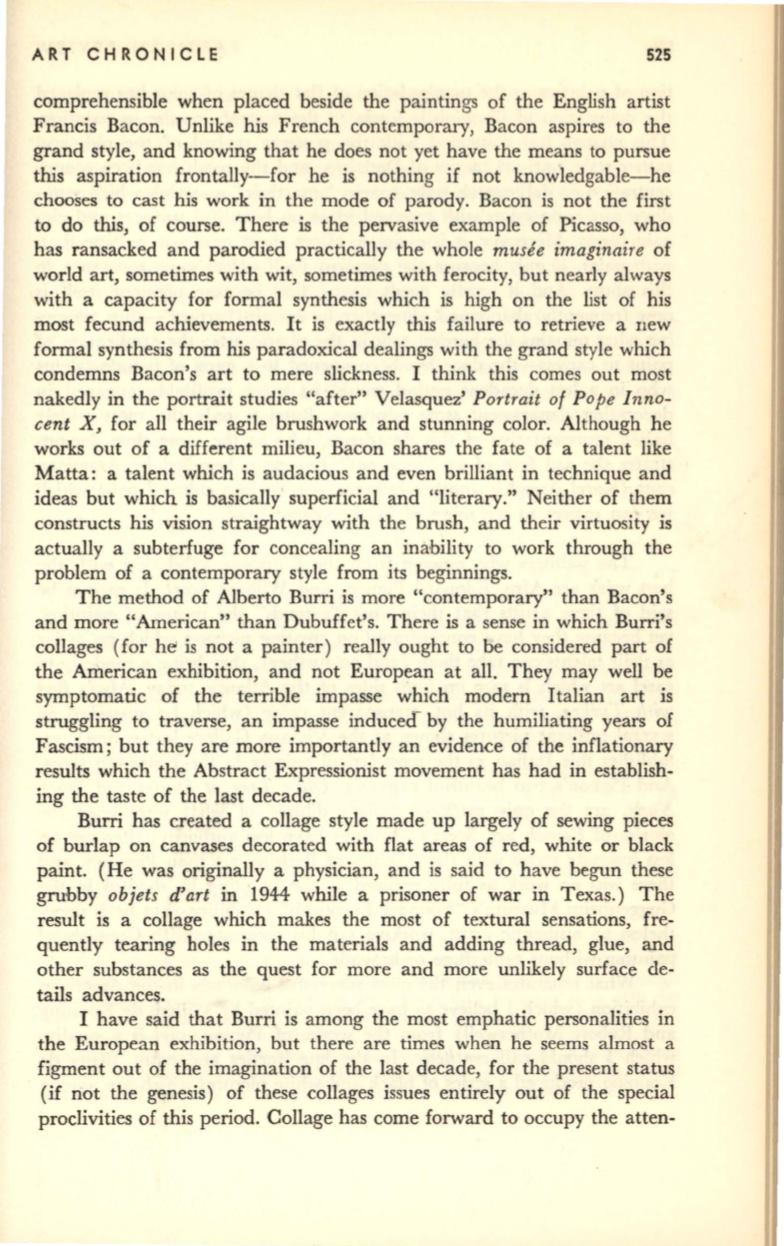
ART CHRONICLE
525
comprehensible when placed beside the pamtmgs of the English artist
Francis Bacon. Unlike his French contemporary, Bacon aspires to the
grand style, and knowing that he does not yet have the means to pursue
this aspiration frontally--for he is nothing if not knowledgable-he
chooses to cast his work in the mode of parody. Bacon is not the first
to do this, of course. There
is
the pervasive example of Picasso, who
has ransacked and parodied practically the whole
musee imaginaire
of
world art, sometimes with wit, sometimes with ferocity, but nearly always
with a capacity for formal synthesis which is high on the list of his
most fecund achievements. It is exactly this failure to retrieve a Ilew
formal synthesis from his paradoxical dealings with the grand style which
condemns Bacon's art to mere slickness. I think this comes out most
nakedly in the portrait studies "after" Velasquez'
Portrait of Pope Inno–
cent X,
for all their agile brushwork and stunning color. Although he
works out of a different milieu, Bacon shares the fate of a talent like
Matta: a talent which is audacious and even brilliant in technique and
ideas but which is basically superficial and "literary." Neither of them
constructs his vision straightway with the brush, and their virtuosity is
actually a subterfuge for concealing an inability to work through the
problem of a contemporary style from its beginnings.
The method of Alberto Burri is more "contemporary" than Bacon's
and more "American" than Dubuffet's. There is a sense in which Burri's
collages (for he' is not a painter) really ought to be considered part of
the American exhibition, and not European at all. They may well be
symptomatic of the terrible impasse which modem Italian art is
struggling to traverse, an impasse inducea by the humiliating years of
Fascism; but they are more importantly an evidence of the inflationary
results which the Abstract Expressionist movement has had in establish–
ing the taste of the last decade.
Burri has created a collage style made up largely of sewing pieces
of burlap on canvases decorated with flat areas of red, white or black
paint. (He was originally a physician, and is said to have begun these
grubby
objets d'art
in 1944 while a prisoner of war in Texas.) The
result is a collage which makes the most of textural sensations, fre–
quently tearing holes in the materials and adding thread, glue, and
other substances as the quest for more and more unlikely surface de–
tails advances.
I have said that Burri is among the most emphatic personalities in
the European exhibition, but there are times when he seems almost a
figment out of the imagination of the last decade, for the present status
(if not the genesis) of these collages issues entirely out of the special
proclivities of this period. Collage has come forward to occupy the atten-


